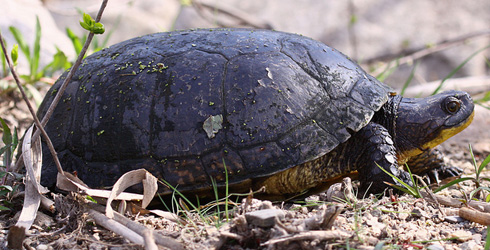
Blanding’s turtle. Image: The Nature Conservancy
Blanding’s turtles may move slowly, but move they do — from habitat to habitat — in ways that highlight the need to better protect the land and water on which they rely.
“In part attributable to habitat loss and degradation, the Blanding’s turtle is considered at risk across most of its range,” according to a recent study about their movements on an island in northern Lake Huron’s Georgian Bay.
It’s classified as endangered in Indiana and Illinois, as threatened in Ontario, Quebec, Wisconsin, Minnesota, New York and Ohio, and as a species of special concern in Michigan.
The Georgian Bay archipelago faces expansion of roads, camps and homes — pitting pressure on Blanding’s turtle habitat, according to field research by biologists at McMaster University in Hamilton, Ontario.
“Effective conservation strategies for species at risk rely on accurate identification of critical habitat, such as areas that individuals use for reproduction, feeding and hibernation,” the study reports. “A key step in generating effective recovery strategies for species at risk is to identify habitat used under a variety of geographic settings.”
Researchers used radio tracking, GPS loggers and aerial imagery to determine how six male and six female turtles use habitats on a 4.2-square-acre (11-square-kilometer) island, which was not named in the study to protect the turtles. The government-owned island is protected as parkland. It has hiking trails, some campsites and a few docks and buildings but no permanent residents.
The researchers are mapping the essential places for turtles on the island chain, said lead author and doctoral student Chantel Markle.
“The archipelago is understudied and undersurveyed in regards to what habitat is suitable for Blanding’s turtles and where these turtles are distributed,” Markle said. “Our model can be used by land managers to determine the sites with high habitat suitability to focus further research and conservation plans.”
Georgian Bay is the world’s largest freshwater archipelago, with more than 30,000 islands. The model could apply to about 300 of those islands that are above a certain size, said biology professor and study co-author Patricia Chow-Fraser.
She said scientists hope that local governments will use the model to designate environmentally sensitive areas that will give them a measure of protection. “We can’t compel the municipalities to use our science. We can only offer it out there.”
Canada has two widely separated populations of Blanding’s turtles, one in the Great Lakes and St. Lawrence River region and the other in Nova Scotia. The McMaster University team also studies the turtles of Lake Erie and Lake Ontario.
The biologists examined how the turtles move during three “behavioral seasons” when they aren’t hibernating: pre-nesting, nesting and post-nesting.
Chow-Fraser said, “We do know they migrate but they have very, very high site fidelity” — meaning that although they may travel almost 4 miles (6 kilometers) to forage for food, they return to their home base for overwintering and nesting.
And gender appears to play a role in where and how they move. Males are most active when they search for mates during the pre-nesting season. Females are most active when making nesting migrations.
Both genders spent most of their time during pre-nesting and post-nesting seasons in bogs.
But during nesting season, females used forest, wet forest and vernal pools — bodies of water formed by melting snow and runoff — and some nested on lichen-filled cracks on a rocky outcrops. At the same time, males stayed in their home wetlands or moved to another bog or a coastal marsh.
Aside from gender, other factors affect habitat selection, such as the amount of rain and snow cover, water depth in the bogs and changes in temperature. Year-to-year differences in precipitation may affect how the Blanding’s turtles use temporary habitats and the timing of their migration, the study said.
When traveling from their home-base wetlands, they primarily use beaver ponds and shallow-water wetlands.
The research findings offer important implications for protection of Blanding’s turtle, according to the study.
“Conservation plans should emphasize the protection of nesting habitats and identify and protect the common habitats used to travel throughout the landscape,” it said
Chow-Fraser said, “The more we know about them, the more we know they’re at risk.”
She cautioned that the new model is site-specific to Georgian Bay. For example, the islands have rocky landscapes and don’t have the sand pits or beaches that the turtles use for nesting along Lake Erie.
The study appeared in the journal Chelonian Conservation and Biology.
I have photographed a large turtle that looks like the Blanding while I was kayaking along the channel between Silver Lake and Lake Michigan. Mears, Michigan near lighthouse. Let me know if u want the photo. 8/2/2020
About 20 miles from the Kankakee River near Manhattan, IL, in a tributary draining a bean field, I’ve notices turtles, that look like the picture you posted.
07/12/15